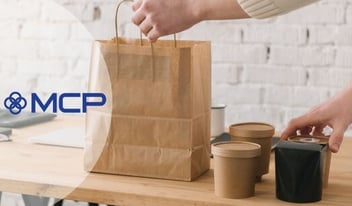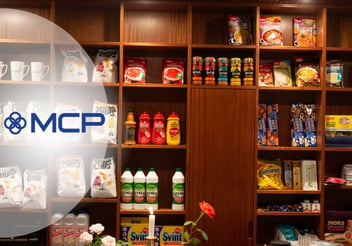
When the local pizza shop delivers a large pie ensconced in a cardboard box, most people give very little thought to the box itself. How was it made? Is the cardboard coated in something to enhance its protective qualities? And why isn’t the box..
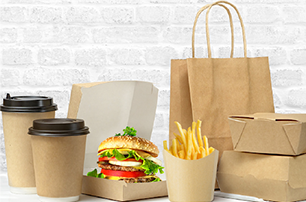 When the local pizza shop delivers a large pie ensconced in a cardboard box, most people give very little thought to the box itself. How was it made? Is the cardboard coated in something to enhance its protective qualities? And why isn’t the box made from something sturdier than paper?
When the local pizza shop delivers a large pie ensconced in a cardboard box, most people give very little thought to the box itself. How was it made? Is the cardboard coated in something to enhance its protective qualities? And why isn’t the box made from something sturdier than paper?
The truth is, paper packaging is an attractive solution for the food and beverage industry for a number of reasons: it’s readily available, it’s flexible, and it’s relatively cost-effective. Unfortunately, untreated cellulosic paper does not prevent the movement of vapor and liquids through its surface. That’s because paper has a porous structure, which makes it possible for even small molecules to pass rather easily through the material. At the same time, the hydroxyl groups of cellulosic fibers decrease paper’s water resistance. Upon contact with water, paper packaging can begin to deteriorate and lose strength. For food packaging, this makes paper and paperboard problematic because they can’t, by themselves, adequately protect what’s inside from contamination, spoilage or leakage.
To overcome these issues, paper manufacturers and converters coat their paperboard products in materials that improve their barrier performance; in essence, the papermakers block the pores of the paper to prevent the transmission of air, water and vapor. These so-called barrier coatings play an important role in ensuring a product’s shelf life by protecting food from the decaying influences of chemical, physical and microbiological elements. Packaging must also remain stable, not interacting with the food so that the appearance, smell, taste and texture of the food remain unchanged by the packaging. Depending on the intended use, coatings may have to meet standards set by the Food and Drug Administration (FDA).

It is possible to make a physical barrier by laminating plastic or aluminum onto paper or paperboard, but this creates some challenges. Papermaking plants must have laminating machines, which can add costs to the packaging. Also, laminated packaging material can be difficult to repulp and recycle. A better solution are synthetic polymer products, which provide an efficient barrier but are much easier to apply and still allow the paper to be repulped and recycled.
The performance of a polymer as a barrier coating is affected by a number of factors, including the choice of monomers and the polymerization process. This blog examines the barrier properties of polymers, how the performance of barrier coatings is measured and how papermakers and converters apply polymer coatings to paper and paperboard.
Barrier Properties of Polymers — Best Types of Polymers for Food Packaging Material
Early barrier coatings for food packaging were made from synthetic polymeric chemicals known as per- and polyfluoroalkyl substances (PFAS). PFAS are a diverse class of compounds characterized by having a hydrophobic (water-hating), fluorine-saturated carbon chain joined to a hydrophilic (water-loving) functional group. This unique structure gives PFAS the ability to repel both water and fat readily. Unfortunately, PFAS can’t be separated from the paper easily, which means the paper can’t be recycled or repulped. The whole family of compounds has also been shown to have harmful effects on human health.
Another class of synthetic polymers, known as emulsion polymers, can also be used as barrier coatings. Like PFAS, emulsion polymers can help extend the shelf life of foods by providing a barrier to moisture vapor and oxygen, and they can provide oil, grease and water resistance. They are also highly flexible materials that can be modified in many different ways. For example, different combinations of monomers, surfactants and other ingredients can affect a key property known as film formation, which describes what happens to an emulsion polymer after it is applied, and the water evaporates. When this occurs, the particles making up the polymer crowd close together, or coalesce, to create a uniform film. Clearly, for a barrier coating to function properly, the polymer film must be sturdy and adhered firmly to the paper surface. It also needs to be somewhat pliable so it can flex when the paper or board flexes.
Film formation is affected by glass transition temperature, or Tg, which describes the range of temperatures over which a polymer becomes less glassy and more rubber-like. A low Tg polymer will be soft at room temperature and form a film more easily. A polymer with a higher Tg will be harder and will not form a film as readily. Consider Rovene® 4100 and Tykote® 1019, two polymers manufactured by Mallard Creek Polymers for use as barrier coatings. Both are styrene-butadiene polymers, but their ratios and formulations are slightly tweaked to change their final functional characteristics. Rovene® 4100 has a Tg of -5°C and is recommended for use as a boxboard coating and in some publication-grade papers. Tykote® 1019 has a Tg of 14°C and exhibits excellent film strength properties, which makes it ideal for use in paper and paperboard coatings where a high degree of water and water vapor resistance is needed, especially in applications requiring FDA clearance.
Emulsion polymers can also be compounded with other materials to enhance barrier performance. For example, formulators might add chemicals that can take advantage of the carboxyl sites on the polymer backbone for crosslinking. Crosslinking, which occurs when adjacent polymer chains link together, can add abrasion resistance to the final coating. Waxes may be added to boost the water resistance of the finished coating.
CAN'T FIND WHAT YOU'RE LOOKING FOR?
Measuring the Performance of Barrier Coatings
The barrier properties of packaging materials most important to the food packaging industry are moisture vapor transmission, liquid water resistance and oil and grease resistance. Chemists use a variety of tests to measure the functional performance of barrier coatings:
Moisture vapor transmission is the transfer of water vapor from one side of a package to the other. The water vapor transmission in a specified time range is measured by the moisture vapor transmission rate (MVTR), also known as the water vapor transmission rate. Standards for measuring MVTR are set by ASTM International and TAPPI, and the units are expressed as either grams/100 in2/day or as grams/m2/day. The lower the MVTR, the better the moisture barrier properties. A properly formulated barrier coating for paperboard can achieve an MVTR measurement of < 10 grams/100 in2/day or < 150 grams/m2/day.
Liquid water resistance is measured by what is known as the Cobb test. A product’s Cobb value reflects the amount of water that is absorbed from one-sided contact of a defined area of paper or cardboard with water in a specified time. The lower the Cobb value, expressed in grams/m2, the more resistant the packaging is to water. A properly formulated barrier coating for paperboard can achieve a Cobb value of <1 grams/m2.
Oil and grease resistance in a barrier coating was traditionally measured by what is known as the Kit test. This test involves applying varying mixtures of castor oil, toluene, heptane and turpentine to a product for 15 seconds. Each mixture is scored a number on a scale of 0 to 12, from least aggressive to most aggressive. The highest numbered mixture that does not stain the surface is reported as the “kit rating.” Hot oils and greases are also used for testing, which better reflect how well a synthetic polymer-based barrier coating resists actual greases that food packaging typically contacts.
Customized Barrier Coating Solutions for the Food Packaging Industry
MCP’s barrier coatings are produced with styrene-butadiene, styrene-acrylic, and all-acrylic water-based emulsion polymers. The polymers are applied to paper, paperboard, and cardboard in thin layers that are sometimes imperceptible to the consumer.
MCP’s Tykote® polymers are designed specifically to help protect paper and paperboard. They form strong films, resulting in continuous, pinhole-free coatings, and impart a broad range of barrier properties. The styrene-butadiene-based Tykotes, such as Tykote 1004 and Tykote 1019, impart excellent water and MVTR resistance and have broad FDA compliances. Tykote 6160 imparts excellent OGR but does have limited FDA food contact compliances, which is why MCP was particularly pleased to announce the arrival of Tykote® 6161 in the fall of 2021. Tykote® 6161 is an all-acrylic water-based emulsion that still provides high barriers to water and oil and grease yet meets FDA 21CFR 176.170 without any restrictive limitations on food types or conditions of use.
A variety of methods can be used to apply barrier coatings for food packaging, including conventional paper machine coaters and off-machine coaters and flexographic printing presses. Choosing the appropriate application process is important to optimize product performance.
Luckily, the chemists at MCP are here to help, both with formulating a polymer with specific barrier properties and with the most efficient ways to apply the polymer to paper or paperboard. Contact us to learn more about our polymer manufacturing process and how MCP can design and produce customized food packaging solutions for your business.
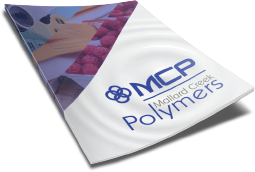
 Construction
Construction
 Nonwovens
Nonwovens
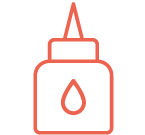 Adhesives
Adhesives
 Textiles
Textiles
 Printing & Packaging
Printing & Packaging
 Paper
Paper
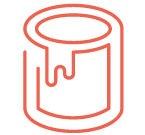 Paints & Coatings
Paints & Coatings



